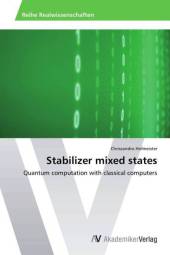 Neuerscheinungen 2013Stand: 2020-01-07 |
Schnellsuche
ISBN/Stichwort/Autor
|
Herderstraße 10
10625 Berlin
Tel.: 030 315 714 16
Fax 030 315 714 14
info@buchspektrum.de |

Chriszandro Hofmeister
Stabilizer mixed states
Quantum computation with classical computers
2013. 96 S. 220 mm
Verlag/Jahr: AV AKADEMIKERVERLAG 2013
ISBN: 3-639-46568-7 (3639465687)
Neue ISBN: 978-3-639-46568-6 (9783639465686)
Preis und Lieferzeit: Bitte klicken
The great physicist Feynman stated 1982 that classical computers are not capable to simulate quantum systems. A classical computer must keep track of a number of variables which grows exponentially with the dimension of the considered system. In the context of complexity theory this cannot be done with efficient effort. Even for the simulation of a few hundred atoms, the information to be stored would exceed the number of all atoms in the universe. Feynman concluded: "I therefore believe it is true that with a suitable class of quantum machines you could imitate any quantum system, including the physical world." However, among quantum mechanical states, the class of so-called stabilizer states overcomes the limitation on classical simulability provided their evolution consists exclusively of Clifford operations. This kind of dynamics can be represented by what is known the stabilizer formalism. Recently computer programs have been developed to simulate quantum systems within this formalism. Feynman would have been surely impressed if he had experienced this by himself. While usually stabilizer states are pure states and their properties well known, this thesis focuses on mixed-state versions obtainable by partial trace over a subsystem of a pure stabilizer state.
Chriszandro Hofmeister had studied physical engineering at the University of Applied Sciences in Coburg. After his prediploma he took up physics at Friedrich-Alexander-University Erlangen-Nürnberg. He worked in the Emmy-Noether-Fellow Group of Peter van Lock at the Max Planck Institute for the Science of Light.


